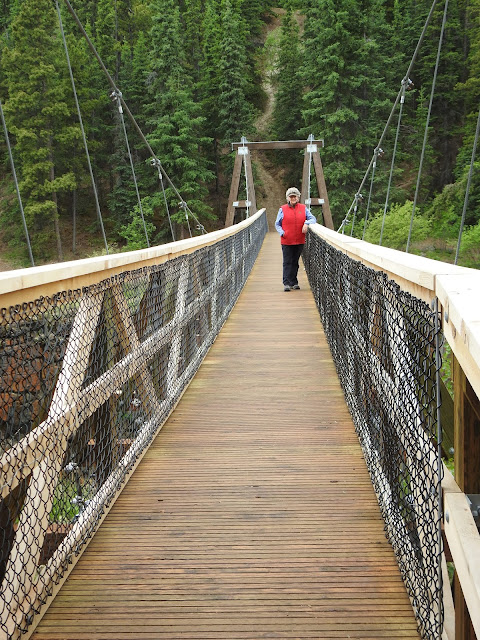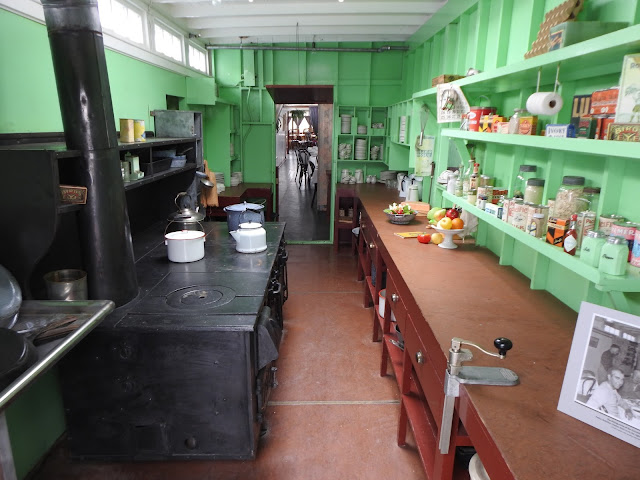Thursday, June 22, 2017
First I need to tell you this is a long post because we crammed a lot into our day. Today we started our excursions with a drive to Miles Canyon.
On our way to Miles Canyon we were driving along side the Yukon River. Sea planes seem to be very popular in this area.
This is our first view of Miles Canyon above. Below Tic zoomed in on the bridge. Then we went to the bridge and hiked around.
I wanted to show a closeup of the rock wall and the color of the water. The rocks looked wrinkled and have orange lichen growing on it. And the water is a light teal color and very clear. I'll show a picture of the clarity later.
The Miles Canyon is created by the Yukon River cutting through a basaltic lava. It was named after General Nelson A. Miles. Originally the locals called this the Grand Canyon.
I'm standing in the middle of this suspension bridge. Tic enjoyed making the bridge bounce as he walked across it.
This picture shows how clear the river is. Oh so beautiful!
From a high point this is the Yukon River just before it enters the canyon.
Next we headed into Whitehorse to see the SS Klondike. She was the largest sternwheeler on the upper Yukon River and launched in 1937. It would carry 4500 bags of ore, each weighting 125 pounds.
The SS Klondike traveled between Whitehorse and Dawson City. a distance of 460 miles, only 5 months out of the year because the river would freeze the other 7 months of the year. The travel time varied greatly depending or whether going up stream or down stream. When heading up stream it would take 4-5 days, making 5-7 wood stops using around 140 cords of wood. Down stream would only take 1.5 days, 1-2 wood stops using around 40 cords of wood.
This is the furnace where the wood was put in to create the steam to run the boat. Look at the size of the logs used. They were not cut any smaller. The crew had to be muscle bound to haul loads of these logs using hand trucks.
Above the bags represent the ore bags carried. Below represents the other cargo also carried. Dawson City relied on cargo from Whitehorse for all their supplies and food.
And barrels of whiskey!
This was a multi purpose boat used as a work boat when needing to help the sternwheeler through sharp turns and also was a lifeboat. Hopefully there was more than one of these when the boat was in operation.
Above is part of the engine room. Below shows the EOT in the engine room. Two telegraph units and alarms must be installed; both on the bridge and in the engine room. The order is given by moving the handle to the desired position on the dial face. This sends an electrical signal to the EOT placed in the engine room whose pointer acquires a position according to the signal given from the bridge. An audible alarm sounds at both ends. Accordingly, the watch-keeping engineer acknowledges the order by moving the handle of the engine room EOT to the required position and takes necessary action. This sends an electrical signal to the Bridge EOT unit, causing its pointer to acquire the respective position. The alarm stops ringing to acknowledge that the order has been carried out.
This is the upper aft deck. The crew and some of the passengers used to play shuffle board on this deck.
Here's the galley looking into the dining area. There was a master cook and a pastry chef.
We were not allowed to go any closer so this is the view of the passenger rooms. There usually were not many passengers.
Tic is looking up at the bridge from the forward deck. Fascinating ship!
Above describes the horse sculpture below. Very creative!
This DC3 is on a free moving pedestal and is actually a wind vane. We have seen it point in different directions. It is mounted in front of the Transportation Museum.
This totem pole is downtown close to the Yukon River.
For the next couple of weeks, the First Nations are building canoes in their tribes fashion and in the original way they were build.
Above and below is one that has birch bark as the outer shell. See below how it is being lashed on.
This picture shows them shaping the wood for the canoe. This one is going to have moose skin as an outer shell.
Above and below you see the canoe (Dugout) that is carved out of a spruce tree.
Here they are making the oars for the spruce canoe. All carving and shaping on all the canoes were being done by hand. No power tools.
This canoe (Qayaq) would have a seal skin outershell.
This is a finished spruce dugout canoe.
Next we went to the Farmer's Market. This piece of artwork is called the Raven House. Ravens are the provincial bird.
Below is just a look at part of the Farmer's Market.
Wow it has been a full day! What a lot of fun!





































No comments:
Post a Comment